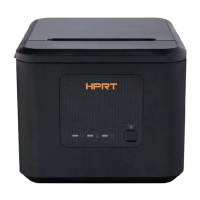This command ends with a NUL code.
When the bar code system used is UPC-A or UPC-E, the printer prints the bar
code data after receiving 12 bytes of bar code data and processes the
following data as normal data.
When the bar code system used is JAN13 (EAN13), the printer prints the bar
code after receiving 13 bytes of bar code data and processes the following
data as normal data.
When the bar code system used is JAN8 (EAN8), the printer prints the bar
code after receiving 8 bytes of bar code data and processes the following
data as normal data.
The number of data for the ITF bar code must be even numbers. When an
odd number of bytes of data is input, the printer ignores the last received
data.
n indicates the number of bar code data bytes, and the printer processes n
bytes from the next character data as bar code data.
If n is outside the specified range, the printer stops command processing and
processes the following data as normal data.
If d is outside the specified range, the printer only feeds paper and processes
the following data as normal data.
If the horizontal size exceeds printing area, the printer only feeds the paper.
This command feeds as much paper as is required to print the bar code,
regardless of the line spacing specified by ESC 2 or ESC 3.
This command is enabled only when no data exists in the print buffer. When
data exists in the print buffer, the printer processes the data following m as
normal data.
After printing the bar code, this command sets the print position to the
beginning of the line.
This command is not affected by print modes (emphasized, double-strike,
underline, character size, white/black reverse printing, or 90° rotated
character, etc.), except for upside-down printing mode.
This command develops bar code data in the print buffer, but does not print
it.
After processing bar code data, this command moves the print position to the
right side dot of the bar code.
If d is out of the specified range, the printer stops command processing and
processes the following data as normal data. In this case the data buffer
position does not change.
If bar code width exceeds the printing area, the printer does not print the bar
code, but moves the data buffer position to the left side out of the printing
area..

